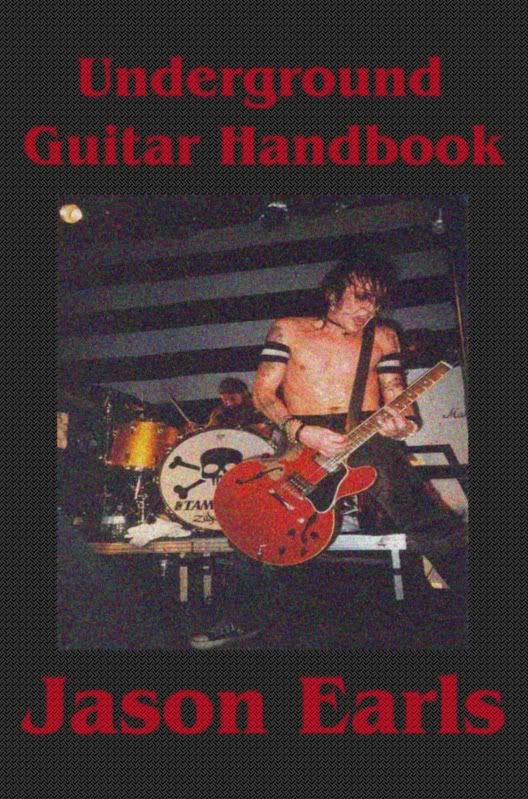by Jason Earls, author of How to Become a Guitar Player from Hell
All of my guitar related articles shouldn’t contain only finger exercises and licks related to soloing on the electric guitar, should they? (I don’t want them to). We could use a little rhythm guitar in here, couldn’t we? (Yes, we could). Grooving and jamming in the pocket with a good drummer, or at least strumming some chords along to a CD, can be a fantastic and wonderful experience and can also make you feel like a champion rhythm guitar player.
Rhythm guitar is of course highly important if you are playing in a band. And one of the most common mistakes beginning guitarists make is that they do not focus on practicing rhythm guitar enough in their initial learning stage, but instead spend too much time attempting to play advanced soloing techniques. (Yes, I was guilty of this mistake.) You don’t want to merely concentrate on solos during the first one or two years of playing the electric guitar, because you won’t be developed enough at that point and many people hearing you solo might think someone is strangling a cat somewhere. Play a few chords once in a while. It won’t hurt anything and it may even feel good. Give your fingers a rest and strum some chords, let the smaller muscles in your hands and digits recuperate, so they’ll grow stronger and bounce back faster when you start soloing again. And when you play rhythm, don’t just play power chords (root and fifth) all the time, throw in some more sophisticated voicings too, as in the examples below.
Here is a simple groove you can practice to help your fingers get used to changing positions and placing them into proper chords shapes quickly and efficiently. The focus here is more on playing the chords and getting your rhythm chops enhanced, rather than displaying any awesome musicality or compositional skills. So go ahead and try this exercise:
-7-7------7-7--------7-7------7-7-------
-8-8------8-8-------7-7------7-7-------
-7-7------7-7--------7-7------7-7------- [repeat]
-9-9------9-9-------6-6------6-6-------
-7-7------7-7--------7-7------7-7-------
------0-0-----0-0--------0-0-----0-0--
-5-5------5-5-------5-5------5-5--------
-6-6------6-6-------5-5------5-5--------
-5-5------5-5-------5-5------5-5-------- [repeat]
-7-7------7-7-------4-4------4-4--------
-5-5------5-5-------5-5------5-5--------
------0-0-----0-0-------0-0------0-0--
The chords above are Emin7, E9, Dmin7 and D9, with the open E played twice between them. You can mute the low E if you like. Here is another way the chords can be listed (but notice they are not in the same order as the tablature above):
- - (E9)- - - - - (Emin7) - - - - - (D9) - - - - - (Dmin7)- -
x 7 6 7 7 7 --- X 7 9 7 8 7 --- x 5 4 5 5 5 --- x 5 7 5 6 5
Notice that in the initial tablature, the chords are written as being played in straight 8th notes, but in real life I would never play them that way. You should spice up the rhythm by doing variations on the timing of the chords. Emphasize some chords longer than others, add some funk try to and groove around a little bit. Play the riff along with a rhythm track or a metronome and add some syncopated strumming and muting and give the chords some flair. (Hopefully you have a decent sense of natural rhythm; if you do not, spicing up the chord progression above while keeping it in proper time may be difficult.)
(If you’d like to see a video of me playing the rhythm figure above, visit my youtube channel at:
http://www.youtube.com/user/zevi35711 – please subscribe while you’re there!)
Also remember that when getting funky with various rhythms, it’s important to let the strumming movement come from your wrist. And you will have to become adept at muting all the strings at any time with both your fretting hand and your picking hand, while being able to quickly transition between the different chord shapes. For strumming practice, you can mute the strings with both hands and generate a rhythmic pattern of “scratching” by strumming all the muted strings at once. (Hopefully this brief strumming advice will help improve your funk level considerably on the electric guitar.)
Concerning rhythm guitar, personally I was guilty of not practicing it as much as I should have at the beginning of my guitar career. Actually, I still don’t focus on rhythm playing enough. But I do love jamming with good drummers. I use a lot of eye contact (nonverbal communication) to incorporate many dynamics and to stay as “tight” as possible with the drummer. Sometimes after spending a lot of time with a good drummer in a band, we have gotten so tight we can improvise using nonverbal cues and occasionally the communication has bordered on being telepathic.
-end-
Bio: Jason Earls is the author of the books Cocoon of Terror, Red Zen, How to Become a Guitar Player from Hell, Heartless Bast*rd In Ecstasy, If(Sid_Vicious == TRUE && Alan_Turing == TRUE) {ERROR_Cyberpunk(); } and 0.136101521283655... all available at Amazon.com and other online book stores. His fiction and mathematical work have been published in Red Scream, Yankee Pot Roast, Scientia Magna, three of Clifford Pickover’s books, Neometropolis, Mathworld, AlienSkin, Recreational and Educational Computing, Escaping Elsewhere, Thirteen, Dogmatika, Prime Curios, Thirteen, the Online Encyclopedia of Integer Sequences, OG’s Speculative Fiction, Nocturnal Ooze, Bust Down the Door and Eat All the Chickens, and other publications. He currently resides in Oklahoma with his wife, Christine.
Subscribe to:
Post Comments (Atom)

No comments:
Post a Comment